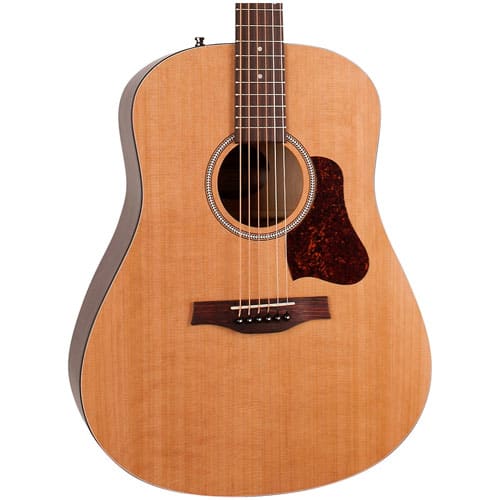Positives
- Amazing sound in this price range, particularly with electronics built in
- Build quality and tonewood choices feel more like instruments that cost more than four times as much
Negatives
- Wide neck on the S6 Original might not be comfortable for some acoustic guitar players
- Plain appearance and cheaper ornamental features make this guitar look drab


The Seagull S6 Review
If you’re looking for exceptional tone and build quality at a reasonable price, look no further than an acoustic from Seagull Guitars.
This Canadian acoustic guitar brand has been striking the right note with its hand-made guitars since being founded by Robert Godin in Quebec in 1982. The Seagull S6 line includes some of the most popular beginner acoustic guitar models on the market today.
Far more than starter instruments, these guitars have been a mainstay on ‘best overall guitar’ lists for years.
Our Seagull S6 review covers the features of the entire S6 lineup, with a focus on the unique features of each S6 guitar. Seagull’s S6 Original is the flagship of the line but the newer models offer plenty of useful additions as well.
Check them all out and decide which one works best for you.
The Body
The Seagull S6 Original offers a dreadnought style body, built with a set of high-end tonewoods. There’s a pressure tested solid cedar top, which pairs with the wild cherry back and sides. Together, these tonewoods and the semi-gloss finish offer a smooth, warm profile.
Both cedar and wild cherry emphasize the midrange of your sound, without a lot of extra boost in either the top or the bottom end. They’re known for their balance and clarity — two factors that come in particularly handy on acoustic guitar. Seagulls guitar have also prioritized local, sustainable woods with the S6, as both the cedar and wild cherry can be found in Canada.
Beyond the Seagull S6 Original, Seagull manufactures a full line of acoustic guitars under the S6 name. These include guitars with dreadnought body shapes, but also concert body sizes. Concert guitars are a bit smaller and curvier than full-size dreadnoughts, making them comfortable to play for longer periods.
The body size also translates into the sound: concert guitars emphasize the midrange and treble, with a bit less rumble in the bass frequencies. This makes them a great fit for fingerpickers who need a bright, clear voice with plenty of articulation in their guitar. Seagull guitars certainly live up to the task in that regard.
The secondary tonewoods — wild cherry and silver leaf maple — are the same across the range and are used for the back and sides of every guitar. The majority of the other S6 models use a pressure tested solid cedar top, although a few use spruce instead.
Compared to the cedar top, the spruce offers a brighter, livelier sound with a bit of extra projection. No matter which tonewood you choose, all of the Seagull S6 guitars use solid pressure-tested tops. This treatment ensures the top is strong enough to withstand the strain of interior braces and boosts the acoustic resonance of the wood.
The Neck and Headstock
Every guitar across the Seagull S6 line features a silver leaf maple neck. They’re topped with rosewood fingerboards, shaped in a 16-inch radius for easy fretting and chording.
The neck offers a custom Seagull S6 profile that’s not too thick but has plenty of heft. It feels roughly in line with many other acoustic guitar necks in terms of depth and shape. Unlike the prominent “V” shape necks of some acoustic guitars, this offers a more common “D” shape neck. It’s a classic, sturdy design that lends itself well to playing a variety of styles.
One of the major distinguishing features of this guitar is the 45mm (1.77-inch) neck width. This is significantly wider than many acoustic and electric guitars and that translates to the feel of the guitar. The wider string spacing makes this a great instrument for fingerpicking and clear, precise playing.
If you’d prefer a thinner neck size, the S6 Slim models are built with a nut width of 43mm (1.69 inches) instead. This is closer to the nut width of an electric guitar and it makes the transition to acoustic easier for electric players. You’ll sacrifice a bit of the fingerpicking clarity, but you might find it easier to play chords and fast lead lines across the neck.
At the end of the neck, you’ll find the slender, triangular headstock. While this might look a bit odd compared to wider “paddle” shaped headstocks, the slimmer profile serves a purpose. The tuning pegs are closer to the paths of the strings, leading to a straighter break over the nut. This design can aid with tuning stability and keep your strings feeling fresh for longer than usual.
The tuners are a set of six Seagull custom machine heads, which keep your tuning stable and easy to adjust at all times. The guitar also offers a compensated Tusq nut, which mimics the sound clarity of a bone nut without the high cost or tough material. Tusq nuts come standard for many high-end acoustic guitar manufacturers, so this is a great feature to find on the Seagull.
Electronics and Pickups
Across the S6 line, you’ll find a few different models with electronics and some without pickups built-in. While the acoustic tone of each guitar is similar, pickups can have a massive impact on your sound when you play live. Having a pickup and preamp built into the guitar is a big advantage for some players, while others don’t see the value in the extra cost.
The S6 Original doesn’t include any pickups, however, you can find S6 models with electronics, identified by the letters “QIT” in the name. All of the Seagull S6 acoustic-electric guitars use Godin QIT electronics systems.
These systems are designed to preserve clarity and articulation, with an onboard piezo pickup underneath the bridge. The piezo pickup style is common on many acoustic guitars, because it allows you to amplify them like an electric guitar, without any visible pickups in the soundhole.
Piezo pickups sense the vibration in the bridge from each note and convert it to the electrified sound that you hear. These pickups are a good way to project acoustic tones on stage, but low-quality models can sound metallic or flat.
Thankfully, the QIT piezo in the Seagull S6 avoids most of the negative features of piezo pickups. It features a touch of electric compression, but not as much as many other piezo models. You’ll still hear your acoustic tone come through clearly, without losing too much articulation or dynamic reach.
This specific pickup system includes an onboard preamp with EQ controls on the upper bout. You can adjust both treble and bass frequencies, as well as the volume of your output signal. The preamp is voiced specifically for Seagull guitars, allowing you a lot of tonal variation from the two EQ controls. There’s also an onboard tuner, which comes in handy on stage.
The Build Quality
Like all Seagull guitars, the Seagull S6 Original is built by hand in Canada. And that extra level of attention is apparent as soon as you pick up an S6. Many players find the S6 offers an exceptional fit and finish for a guitar in this price range, particularly in the smaller details that many budget acoustics often miss.
Other Reviews Worth Checking Out
How Does it feel to play?
If you’re used to playing acoustic guitars with a high-gloss finish, the semi-gloss finish on the S6 might feel a bit odd. It’s definitely more “natural” than high-gloss guitars, although it doesn’t feel as raw as a satin finish. Overall, it’s a good mix between the two extremes. It’s got enough gloss for a premium look and feel, but it won’t pick up fingerprints or feel tacky.
The neck shape is good for a variety of styles, although the fingerboard width is a bit more restrictive. As we touched on briefly above, the S6 Original has a 45mm fingerboard width, while the S6 Slim has a 43mm fretboard at the nut. If you want to play fingerpicking, folk, bluegrass or classical, the Original’s wider string spacing should serve you well.
On the other hand, the narrower feel of the S6 Slim is great for fast, quick playing that feels a bit closer to an electric guitar. This neck is a bit easier to wrap your hands around, particularly if you have smaller palms or short fingers.
If you like to place your thumb around the top of the neck, either neck size should work well for you. Using your thumb to cover the first few strings is a great way to make wider necks feel smaller and more comfortable to play.
Most of the S6 models come with a dreadnaught body size. This is one of the largest acoustic guitar sizes, and it provides great projection and bass tone. If you’re a smaller player or a new musician, you might struggle to wrap your arms and body around the dreadnaught comfortably.
For an instrument that feels better to play, the S6 Concert model is a good alternative. This guitar feels almost the same as the S6 Slim models in the neck and fretboard, but uses a smaller body to add a level of comfort when you play.
How good is the sound quality?
Considering its price, the sound quality on the Seagull S6 is nothing short of exceptional. It delivers fun, upbeat tones that sound just as energetic as some guitars that cost more than twice its price.
The main feature of the S6 is its balance. If you listen to a S6 live, you’ll hear how the different frequencies interact, without any one range overpowering the other. The bass is tight and crisp, the midrange is smooth and lively and the treble is bright and clear.
The solid cedar top found on the S6 Original is another main selling point for sound quality. Unlike spruce tops, which take some time to break in before they sound their best, a cedar top can reach its full tonal response very quickly.
This quicker break-in time helps you achieve the smoky midrange and warm, dynamic articulation of a cedar top right away. If you buy a Seagull guitar, you won’t need to worry about breaking it in — it will sound great right out of the box.
It’s true that the S6 offers a bit less bass than some other acoustics. If you want a heavy, thick low end, you’ll need to strum a bit harder in the bass strings and that extra effort can make it tough to stay precise and relaxed as you play. For that reason, some players who prefer that “boomier” acoustic sound might prefer a Martin, or another brand of acoustic.
While that may be a “negative” for a few players, it’s actually a big selling point for many others. If you’re not looking for a heavy, overpowering bass response, it’s easier to play the Seagull S6 with more dynamics and touch. Fingerpicking players in particular will love the lighter, more balanced sound. The S6 guitar affords more clarity and allows their articulation and phrasing to shine through.
No matter what style of guitar you play, a good set of strings will always make your instrument sound better. These Elixir 80/20 Phosphor Bronze strings utilize a Nanoweb coating, which prolongs the life of each string without sacrificing their tone and character. If you want to get the most out of your Seagull S6, you should check them out.
Wrapping Up
If you don’t have a lot of money to spend, you might think you can’t find a quality acoustic guitar. But, as our Seagull S6 review shows, the S6 lineup proves such thoughts wrong.
For a line of budget acoustic guitars, Seagull has managed to create some exceptional instruments. The Seagull S6 Original sounds smooth and lively and its build quality compares with high end guitars that cost hundreds of dollars more.
No matter what style of guitar you play, the S6 lineup offers something for everyone. The thin necks of the S6 Slim, the built-in pickups of the QIT models and the smaller concert bodies help suit guitar players of all different genres.
Click here to check out a few more awesome acoustic guitars. If you’d like to check out a great guitar: the Seagull S6 Original, you can find more information here.



